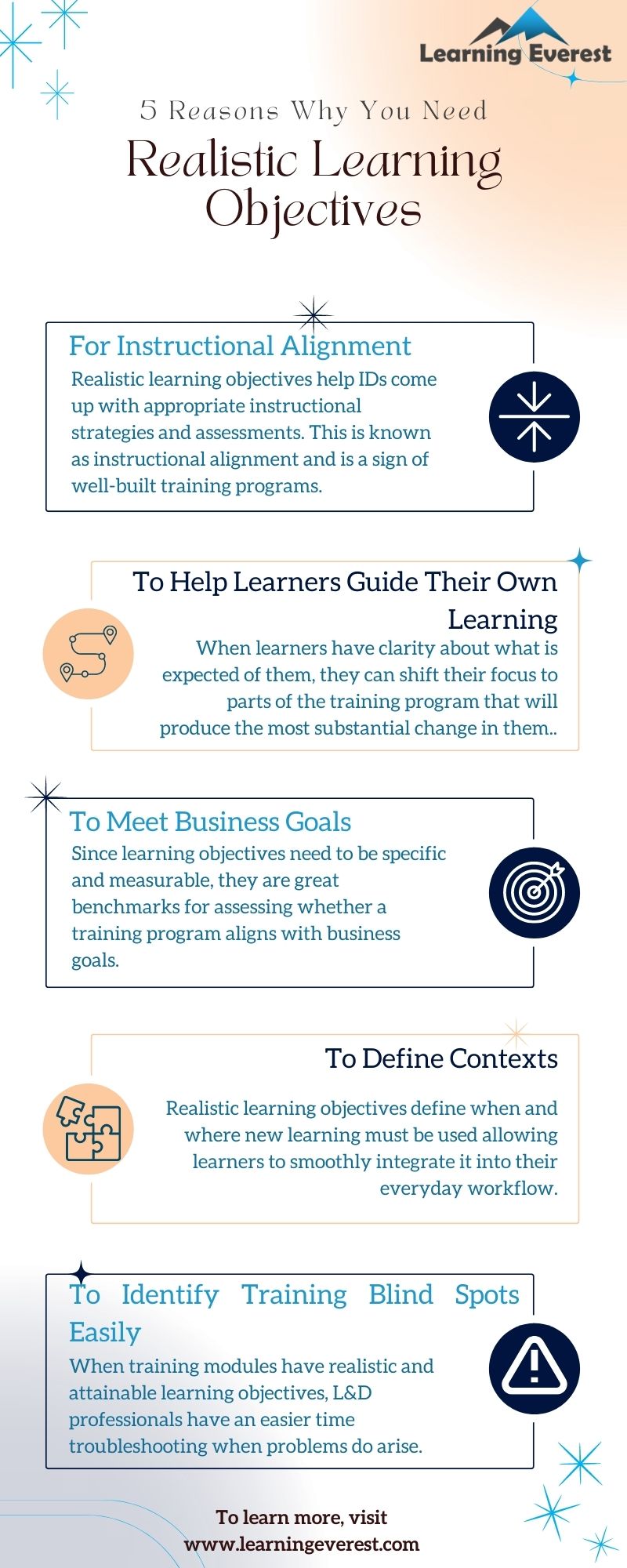When designing a training program, it is important that you set realistic learning objectives. While ambition is welcome in organizational development in general, learning objectives need to be concrete and set achievable expectations for learners and management alike. They influence everything from instructional design and assessment effectiveness to learners’ emotional states and overall experience while taking the course. Thus, learning objectives are foundational in creating compelling training modules that produce the desired change in learners. This article will give you 5 reasons why realistic learning objectives are important.
Table of Contents
Defining Learning Objectives
A learning objective is a statement that describes attitudes, skills, or knowledge a learner is expected to display at the completion of a specific learning activity.
A well-written learning objective is specific in its scope, measurable, and delineates an observable action as the indicator for successful learning.
Why You Need Realistic Learning Objectives
From the description above, you might have been able to tell that learning objectives set the tone for the entire learning process. Let us dive deeper into the importance of realistic learning objectives:
No. 1: Realistic Learning Objectives Create Instructional Alignment
All good instructional design is based on the Golden Triangle of learning objectives, instructional methods, and assessment.
The instructional designing process begins with setting learning objectives. Based on these objectives, the subsequent instructional methods and assessments for the course are developed. If the learning objectives in this golden triangle are well-written, the instructional methods and assessments automatically become more relevant and have a higher likelihood of changing learners’ attitudes, skills, or knowledge in the desired direction.
This condition is known as instructional alignment. Instructional alignment ensures that your L&D resources are put to good use.
Part of what makes a learning objective well-written is whether it lays down an achievable goal for learners to work towards. Thus, realistic learning objectives facilitate instructional alignment for highly effective and relevant learning activities.
No. 2: Realistic Learning Objectives Help Learners Guide Their Own Learning
Learners form their own expectations for learning outcomes based on the learning objectives presented to them at the beginning of a course or learning activity.
Realistic learning objectives make it easier for learners to envision their progress through the course. They also set down goals for learners to work towards. When learners have clarity about what is expected of them, they can shift their focus to parts of the training program that will produce the most substantial change in their current skill set or knowledge base.
This allows learners to engage more meaningfully with course content. Meaningful engagement leads to more enhanced learning, allowing learners to make the best out of the training program.
No. 3: Realistic Learning Objectives Ensure Training Meets Business Goals
Since learning objectives need to be specific and measurable, they are great benchmarks for assessing whether a training program aligns with business goals.
Additionally, due to the concept of instructional alignment discussed above, realistic learning objectives can help instructional designers fine-tune training content to fit business goals. Key performance indicators can be weaved into learning objectives to achieve this.
No. 4: Realistic Learning Objectives Define Contexts
New behaviors cannot be performed randomly. Similarly, it is rare for new knowledge to be applicable ubiquitously. Typically, each training area has certain conditions or contexts where it needs to be applied.
For example, in a bank, a customer service rep would not screen new applications and an applications analyst would not deal with service-related grievances.
Thus, both these groups of employees have skill sets that can only be effectively applied to the operations they are responsible for.
Realistic learning objectives take such contexts into account and define them for learners so they know when they will need the new information they are learning and when they will not.
This leads to more clarity for learners regarding the purpose of training and they can smoothly integrate their new knowledge or skills into their everyday workflow after completing the course.
No. 5: Realistic Learning Objectives Make It Easier to Identify Training Blind Spots
Lastly, when training modules have realistic and attainable learning objectives, L&D professionals have an easier time troubleshooting when problems do arise.
If the training fails to produce the expected results after completion, course content and assessment can be compared with learning objectives to identify the potential factors at play.
Infographic

5 Reasons Why You Need Realistic Learning Objectives
Conclusion
Realistic learning objectives create a cascading effect of positive training outcomes. They influence everything from course design and content to learners’ expectations. Incorporating business goals into realistic learning objectives is easier as they are specific, measurable, and observable, thereby creating a clear criterion to indicate whether training was effective or not. Additionally, assessing training blind spots becomes an easier task when you have a clear set of objectives to compare them against.





